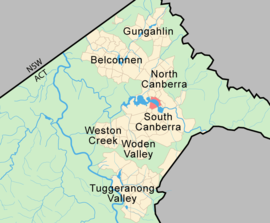Parkes, Australian Capital Territory
| Parkes Canberra, Australian Capital Territory | |||||||||||||||
|---|---|---|---|---|---|---|---|---|---|---|---|---|---|---|---|
 | |||||||||||||||
| Population | 4 (2006 census)[1] | ||||||||||||||
| • Density | Lua error: Unable to convert population "4 (2006 census)'"`UNIQ--ref-00000000-QINU`"'" to a number. | ||||||||||||||
| Gazetted | 20 September 1928 | ||||||||||||||
| Postcode(s) | 2600 | ||||||||||||||
| Area | 3.03 km2 (1.2 sq mi) | ||||||||||||||
| District | South Canberra | ||||||||||||||
| Federal division(s) | Canberra | ||||||||||||||
| |||||||||||||||




Parkes (postcode: 2600) is an inner suburb of Canberra, Australian Capital Territory, Australia. Located south of the Canberra CBD, Parkes contains the Parliamentary Triangle area. On Census night 2006, Parkes had a population of 4 people. [1]
Parkes is named after Sir Henry Parkes, a Federalist, legislator and one of the founders of the Australian Constitution. Streets in Parkes are named after monarchs and constitutional references. [1]
Parkes contains many of Canberra's large institutions and contains no residential area.
See also
Notable places
- Commonwealth Park
- Kings Park
- Regatta Point
- Commonwealth Place
- Central Basin of Lake Burley Griffin
- National Carillon
- National Library of Australia
- National Science and Technology Centre
- High Court of Australia
- National Gallery of Australia
- National Portrait Gallery
- Old Parliament House
- National Rose Garden
- Aboriginal Tent Embassy
- Reconciliation Place
- East Block
- West Block
Geology

The geology of Parkes has been studied in great detail. Canberra Formation, calcareous shale is found in the lower parts. This overlies middle Silurian Camp Hill Sandstone. The sandstone unconformably overlies the early Silurian Black Mountain Sandstone and State Circle Shale. State Circle Shale is Late Llandovery in a more finely divided time scale and has been dated to 445 ±7 million years old. The State Circle Shale is composed of laminated shales and siltstone. Black Mountain Sandstone is composed of a white quartz sandstone.
Footnotes
- ^ a b Australian Bureau of Statistics (25 October 2007). "Parkes (State Suburb)". 2006 Census QuickStats. Retrieved 2009-05-03.
